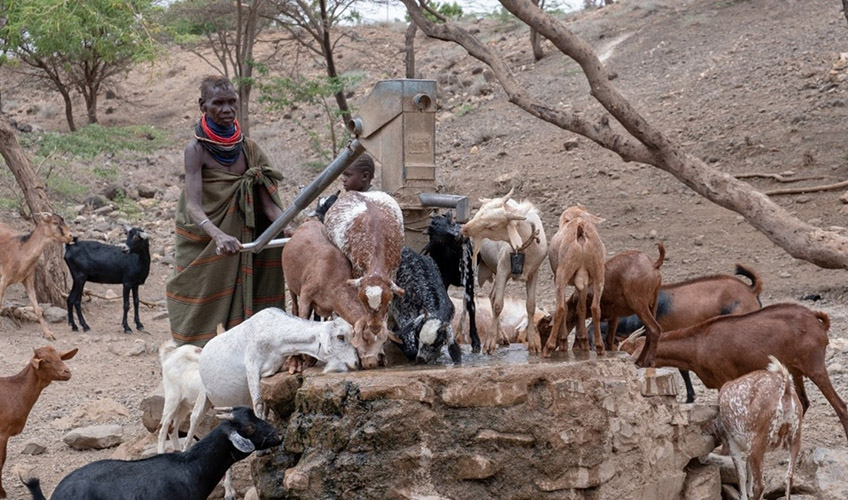To succeed, COP27 must put conflict on the agenda
Climate and conflict are two sides of the same coin. The impact of climate change is felt most keenly in regions already affected by violence. These regions are essential in the global effort to reduce carbon emissions, yet also receive the least climate adaptation support. If COP27 is to seriously tackle the climate crisis, then conflict must be on the agenda.

Climate change is recognised as a ‘threat multiplier’, meaning that it accelerates and exacerbates other drivers of instability. We’re already seeing the implications on the ground. The Horn of Africa is going through its worst drought in history. Farmers have been unable to harvest their crops for five consecutive seasons. Pastoralist communities have lost much of their livestock. At least 20 million people are facing acute food insecurity.
For the pastoralist and fishing communities of the Lake Turkana region of northern Kenya, at the border with Ethiopia and South Sudan, the climate-induced changes to their environment represent an existential threat to a traditional way of life.
Environmental pressures are causing an increase in the competition for natural resources, particularly water and pasture. Cattle-theft, banditry and displacement has resulted in significant loss of life and continued cycles of violence. The crisis has heightened the risk of sexual and gender-based violence, with female-headed households and adolescent girls particularly vulnerable. These conflicts spill over national and international political borders.
“The natural resources are used for economic, spiritual, cultural and ecological purposes,” explains Ikal Ang’elei, from the grassroots indigenous organisation Friends of Lake Turkana. “The lake is important not only for their livelihood, but also for their identity.”
Kenya recognises climate change as a crucial factor in its security, stability and development ambitions. It has developed policies to minimise the impact, including Kenya Vision 2030 and the Climate Change Act, and aims to achieve 100% sustainable renewable energy sources by 2030. It is already a leader of the green energy movement in Africa and is well placed to make a successful green energy transition. Green energy projects, including solar panels and wind farms, as well as the materials needed for renewable batteries, are seeing an enormous wave of investment.
But these projects are jeopardising peace and stability by failing to adopt conflict-sensitive approaches in their operations. Major developments can exacerbate existing tensions and conflicts, not only risking violence in the short term, but also the viability of green investment going forward. Land grabs by governments and international companies often result in population displacement and localised outbreaks of violence.
The Lake Turkana Wind Power Project, for example, is the largest wind energy project in sub-Saharan Africa and the biggest public-private investment in Kenya’s history. The project is operated in one of the most marginalised and remote areas of the country with significant transhumance (moving livestock between grazing grounds) activities. Yet by failing to understand the local context, recognise the rights of indigenous people to their land and meaningfully engage the wider affected communities, this flagship project almost never happened.
With COP27 taking place right now, it is beyond time to bring conflict into the debate. This COP is said to be an ‘African COP’ that will put the priorities of the African continent forward. This refers to a lack of climate finance, but also a flawed distribution, with the finance not reaching the most fragile countries.
Conflict risks need to be discussed as part of the international climate negotiations agenda. These arguments strongly call for meaningful cooperation between the climate and peacebuilding sectors, crucial to achieving climate neutrality and climate action that can ensure sustainable peace.
The peacebuilding sector is far from being alone in voicing this urgent need for change. The new Intergovernmental Panel on Climate Change (IPCC) report contains important findings on the links between climate change and conflict, recognising that “there is robust evidence that inequitable responses [to climate change] further exacerbate marginalisation, exclusion or disenfranchisement of some populations, which are commonly recognised drivers of violent conflict”.
Germany intends to establish a ‘Climate, Environment, Peace and Security Initiative’ with like-minded allies. This group intends to be project oriented, to move from studies to action, and will have a global scope. Egypt intends to launch a ‘Climate Responses for Sustaining Peace Initiative’ at COP27. It plans to implement programmes and activities with an African focus, including adaptation to climate change in connection with strengthening peacebuilding efforts and finding sustainable solutions that address the relationship between climate change and displacement. These developments are of course welcome, but conflict still remains absent from the official agenda of climate finance negotiations and this needs to change.
Without considering the implications for conflict in some of the world’s most fragile places, the global climate agenda will fail those most in need. We can’t afford to let that happen.






